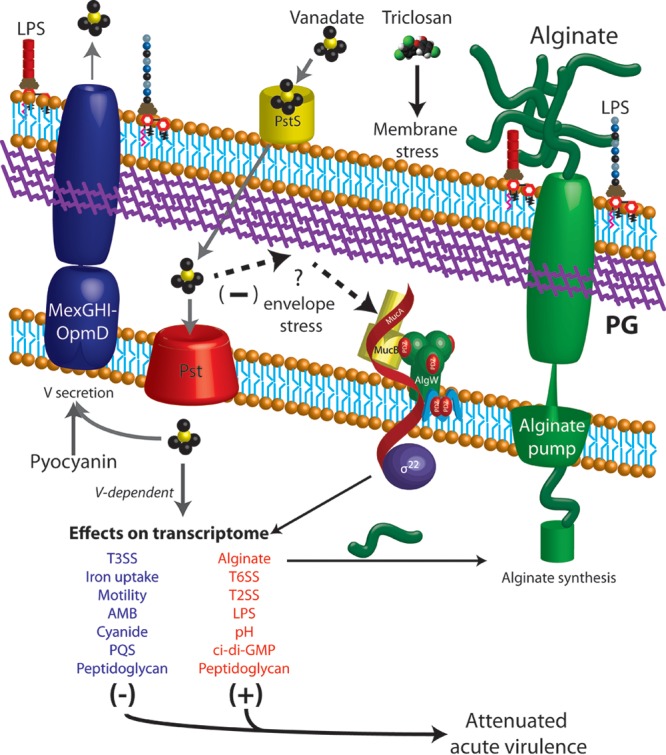Fig 6.

Model of envelope stress caused by PIAAMV leading to global gene expression changes and attenuated virulence in P. aeruginosa. PIAAMV is a medium composed of standard Pseudomonas isolation agar supplemented with 0.34 mM ammonium metavanadate. Vanadate is indicated by the yellow and black structures. Our previous study suggested the P. aeruginosa activates overproduction of the exopolysaccharide known as alginate as a stress response (21). Degradation of the anti-sigma factor MucA during growth on PIAAMV leads to activation of alginate gene expression and secretion of alginate (21). In this study, we screened the PA14 nonredundant library of transposon mutants, which led us to propose the following model. Triclosan from PIA causes membrane stress, as others have described (71). The addition of vanadate to PIAAMV activates alginate overproduction. Mutants of the phosphate transport system were nonmucoid on PIAAMV, which suggested that vanadate may be taken into cells by this system. Due to the identification of several mutants of hydrolytic enzymes involved in peptidoglycan remodeling, we propose that either vanadate may have a direct effect on peptidoglycan or peptidoglycan remodeling might be a way of alleviating the stress caused in the envelope by vanadate. Other mutants suggest that vanadate affects proteins in the cytoplasm. Inactivation of genes involved in pyocyanin biosynthesis suggested that vanadate may be secreted from the MexGHI-OpmD efflux pump, as others have indicated (63). Transport of vanadate is indicated with gray arrows. Vanadate causes both repression and activation of many key virulence systems (see Table S1 in the supplemental material). We note that genes involved in peptidoglycan synthesis and remodeling are both activated and repressed. Furthermore, laboratory strain PAO1 is attenuated when cultured on PIAAMV. Our study suggests that vanadate causes specific effects and envelope stress on P. aeruginosa and may be useful for understanding the various stress response networks. AMB, l-2-amino-4-methoxy-trans-3-butenoic acid; PQS, Pseudomonas quinolone signal.
